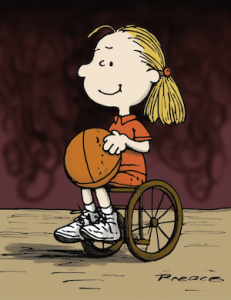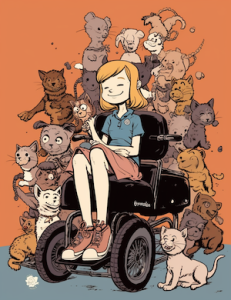Introduction
Here comes a person in a wheelchair. What comes to mind? Do your thoughts contain myths, misconceptions or incorrect stereotypes about people using wheelchairs?
Before acquiring a spinal cord injury (SCI) in 2009, I knew little about people zooming around in wheelchairs.
My blog shares 20 Wheelchair myths, misconceptions and incorrect stereotypes to improve your understanding of the people using wheelchairs. I will add a few comments, in italics, about living with my disability of paraplegia.
But wait, there is more! For today only, I share another 30, taking the total to 50 Wheelchair myths, misconceptions and incorrect stereotypes.
The first 10 Wheelchair myths, misconceptions and stereotypes
-

They’re all the same: Not everyone in a wheelchair has the same condition or reason for using one.
- They can’t feel their legs: Some people can feel and even move their legs but use wheelchairs for mobility support. (I can’t feel my legs).
- They’re always dependent: Many wheelchair users are independent and manage many, if not all, aspects of their daily lives.
- They can’t work: Many individuals in wheelchairs have successful careers across various sectors. (I could work, but I don’t need to).
- They can’t be parents: Many wheelchair users have children and are active, loving parents. (I’m a father to two children).
- They’re not active: Wheelchair users can be athletes, travellers and more.
- They all want to be “cured”: Not everyone sees themselves as broken or needing curing.
- They lack intelligence: Physical disability doesn’t equate to cognitive impairment. (After my accident, I completed a diploma and always learning about new technologies).
- It’s okay to push their wheelchair without asking: Always ask for permission. It’s a matter of respect and autonomy.
- They’re always sad about their condition: Many wheelchair users live fulfilling, happy lives and accept their disability. (True!)
Another 10 Wheelchair myths, misconceptions and stereotypes
 They can’t live alone: Many live independently and manage their households. (After my kids moved out, I lived alone until one of them moved back in).
They can’t live alone: Many live independently and manage their households. (After my kids moved out, I lived alone until one of them moved back in).- They can’t drive: Adaptive vehicles allow many wheelchair users to operate. (My VW Transporter just celebrated its 10th birthday).
- They don’t care about fashion: Wheelchair users have diverse personal styles and can be fashion-conscious.
- They’re a safety hazard: With proper access and infrastructure, they’re not.
- They can’t participate in sports: Many adaptive sports cater to wheelchair users.
- Their lives are less fulfilling: Quality of life isn’t solely based on mobility.
- They’re always in pain: Not every wheelchair user is in constant pain. (My pain levels never go below 5 and increase during the day).
- They’re an inspiration for simply existing: “Inspiration porn” can be demeaning. (I don’t mind if you use the term ‘inspiration’).
- They can’t travel: Many wheelchair users travel domestically and internationally. (I’ve travelled to all of the capital cities in Australia).
- They don’t go out much: Many are as socially active as anyone else. (I go out more often than most of my friends).
Another 10 Wheelchair myths, misconceptions and stereotypes
-

They don’t exercise: Physical fitness is essential to many wheelchair users. (My home has a wheelchair-accessible gym and swimming pool).
- All are paraplegic: Reasons for using wheelchairs are diverse.
- They can’t do household chores: Many adapt and manage their homes effectively. (I do many chores and employ people to help).
- They can’t participate in artistic endeavours: Wheelchair users are artists, musicians, writers, etc. (I create blogs and books).
- They have lesser goals or dreams: Ambitions aren’t tied to mobility.
- They all know each other: Being in a wheelchair doesn’t mean they know all other wheelchair users. (I have more friends that aren’t in wheelchairs).
- They don’t enjoy outdoor activities: Many enjoy parks, beaches, hiking, etc.
- They’re easy to scam or deceive: This stereotype is incorrect and harmful. (Yet to be a victim of a scam).
- They have limited education: Many wheelchair users have advanced degrees and qualifications. (I have a Bachelor of Applied Science in Computer Studies and a Diploma in Writing and Publishing).
- They lack autonomy: Many make independent choices daily.
Another 10 Wheelchair myths, misconceptions and stereotypes
 They can’t cook: Many wheelchair users excel in culinary arts.
They can’t cook: Many wheelchair users excel in culinary arts.- They have weak upper bodies: Many have strong upper bodies due to wheelchair propulsion. (I go to the gym 3 or 4 times a week).
- They want to discuss their disability: Some do, many don’t. Respect boundaries. (It’s OK).
- All wish they could walk: Walking isn’t a universal desire among all wheelchair users. (No, zooming around is faster than walking).
- They can’t use public transportation: Many public systems are accessible.
- They’re financially dependent: Many are economically independent. (I don’t rely upon a government pension).
- They don’t socialize: Many are socially active, with wide circles of friends.
- Their wheelchair is a burden: For many, it’s a tool of freedom.
- They’re always sickly: Being in a wheelchair doesn’t equate to poor health. (I catch colds less often now).
- They avoid crowded places: Many navigate and enjoy events, concerts, and more.
The final 10 Wheelchair myths, misconceptions and stereotypes
 They’re always on government aid: Many work and don’t receive any support.
They’re always on government aid: Many work and don’t receive any support.- They can’t care for pets: Many wheelchair users have and care for pets. (My cat is Spartacus).
- Their lives are tragic: Such a stereotype can be overly simplifying and demeaning.
- They don’t go to concerts or festivals: Many enjoy live events.
- They can’t be successful: Many wheelchair users are incredibly successful in various fields.
- They’re not tech-savvy: Many are proficient or even experts in technology. (Love technology such as home automation and AI).
- They’re humourless about their condition: Many have a great sense of humour, including their disability. (I’d be a stand-up comedian, but I can’t stand).
- Wheelchairs are always slow: Some wheelchairs, primarily powered ones, can be pretty fast.
- They can’t handle responsibilities: Responsibilities are managed by many, regardless of mobility.
- They don’t engage in self-improvement: Many continually strive for growth.



 They can’t live alone: Many live independently and manage their households. (After my kids moved out, I lived alone until one of them moved back in).
They can’t live alone: Many live independently and manage their households. (After my kids moved out, I lived alone until one of them moved back in).
 They can’t cook: Many wheelchair users excel in culinary arts.
They can’t cook: Many wheelchair users excel in culinary arts. They’re always on government aid: Many work and don’t receive any support.
They’re always on government aid: Many work and don’t receive any support. Please comment on your thoughts about the 20 Wheelchair myths, misconceptions and stereotypes.
Please comment on your thoughts about the 20 Wheelchair myths, misconceptions and stereotypes.
Hi John. I follow many of your posts and enjoy reading them. I found this post very interesting, and particularly liked your added personal experience additions on the points. Thanks for sharing.